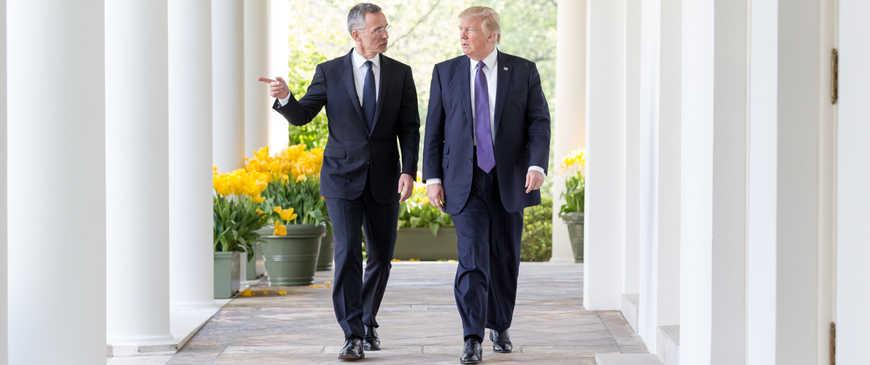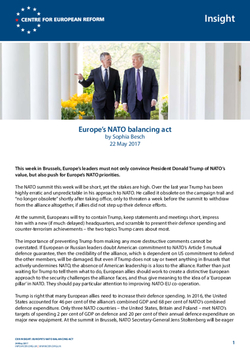
Europe's NATO balancing act
This week in Brussels, Europe’s leaders must not only convince President Donald Trump of NATO’s value, but also push for Europe’s NATO priorities.
The NATO summit this week will be short, yet the stakes are high. Over the last year Trump has been highly erratic and unpredictable in his approach to NATO. He called it obsolete on the campaign trail and “no longer obsolete” shortly after taking office, only to threaten a week before the summit to withdraw from the alliance altogether, if allies did not step up their defence efforts.
At the summit, Europeans will try to contain Trump, keep statements and meetings short, impress him with a new (if much delayed) headquarters, and scramble to present their defence spending and counter-terrorism achievements – the two topics Trump cares about most.
The importance of preventing Trump from making any more destructive comments cannot be overstated. If European or Russian leaders doubt American commitment to NATO’s Article 5 mutual defence guarantee, then the credibility of the alliance, which is dependent on US commitment to defend the other members, will be damaged. But even if Trump does not say or tweet anything in Brussels that actively undermines NATO, the absence of American leadership is a loss to the alliance. Rather than just waiting for Trump to tell them what to do, European allies should work to create a distinctive European approach to the security challenges the alliance faces, and thus give meaning to the idea of a ‘European pillar’ in NATO. They should pay particular attention to improving NATO-EU co-operation.
Trump is right that many European allies need to increase their defence spending. In 2016, the United States accounted for 46 per cent of the alliance’s combined GDP and 68 per cent of NATO’s combined defence expenditure. Only three NATO countries – the United States, Britain and Poland – met NATO’s targets of spending 2 per cent of GDP on defence and 20 per cent of their annual defence expenditure on major new equipment. At the summit in Brussels, NATO Secretary-General Jens Stoltenberg will be eager to demonstrate progress. And indeed, in 2016, 23 European NATO countries increased their national expenditure on defence in real terms, and 16 of those increased it as a share of GDP.
In many cases, however, these increases were minimal. Some European defence ministers are constrained by overall fiscal tightening, or find it difficult to justify spending public money on defence to their electorates. Many European voters are particularly opposed to the idea that their defence policies and public spending priorities should be determined by the Trump administration. In the German general election campaign, the social democrats (SPD), though part of Angela Merkel’s government, criticised her for accepting the American view that equates transatlantic burden-sharing with higher defence spending, ignoring other ways in which countries could contribute to European security.
Even if Europeans can appease Trump in Brussels, the absence of US leadership is a loss to #NATO
Europeans have self-interested reasons to invest in their own military power. At the last NATO summit in Warsaw in 2016, the allies agreed on an ‘Enhanced Forward Presence’ in Central and Eastern Europe. As part of NATO’s effort to reinforce its deterrent against Russia after the illegal annexation of Crimea in 2014, four battle groups (around 4,000 troops altogether) will be sent to Estonia, Latvia, Lithuania and Poland on a semi-permanent, ‘rotational’ basis by summer 2017.
Trump, however, has said the US might not defend its allies in the event of a Russian attack, unless they had “fulfilled their obligations” to the US. Defence Secretary James Mattis quietly contradicted this statement and others Trump made on the campaign trail: during a visit to NATO troops deployed in Lithuania he called the American commitment to NATO’s Article 5 “ironclad”. Nonetheless, Europeans rely too heavily on North American support in Eastern Europe. Of the four battlegroups, only two are led by Europeans – Germany leads troops in Lithuania, and Britain those in Estonia. The United States and Canada command the other two. As Europe is faced with the risk of weaker American support, European allies have to invest in capabilities that enable them to maintain their commitment to Article 5.
But increasing European defence budgets is not enough. If governments increase their spending to 2 per cent of GDP without more European co-operation on procurement and development, they risk all buying the same things and spending more money. So while it is important to demonstrate to President Trump that Europe spends more on defence, Europeans in NATO should focus on a ‘European way’ of increasing the capabilities the alliance can access. Two approaches are particularly promising.
First, European allies should jointly acquire weapon systems and platforms that they can use for NATO and non-NATO purposes. A good example is the recent initiative by the Netherlands, Luxembourg, Belgium, Germany, and Norway to acquire new tanker aircraft to reduce Europe’s reliance on the United States for air-to-air refuelling. NATO Deputy Secretary General Rose Gottemoeller was right to say in February that by co-operating, NATO countries could “significantly improve their armed forces while ensuring the greatest value for money for their taxpayers.”
Second, Europeans should ensure that NATO also benefits from the EU’s big new plan to include money for defence in the next multiannual financial framework (MFF). This budget will fund collaborative research in new defence technology, for example in the field of encrypted software or robotics. Of the 28 alliance members, 22 are also members of the EU (and others, like Norway, have association agreements that allow them to access EU funds). NATO should make sure that its own defence plans are co-ordinated with those of the EU.
Besides his comments on defence spending, President Trump has also said that he wants NATO to do more counter-terrorism operations in the Middle East; and those allies for whom Russia is the main threat have acquiesced in making counter-terrorism central to the Brussels summit. Notably, Trump wants NATO to become a formal member of the anti-ISIS coalition. At the moment, all European NATO members are already involved at a national level, and NATO supports the coalition with surveillance planes.
While allies may agree to Trump’s request at the summit in order to send a political message of support, many European leaders have already expressed their concern about giving NATO a bigger role in the coalition. France, Italy and Germany in particular think that involving a purely military organisation like NATO in counter-terrorism operations could alienate Middle Eastern countries and make regional partners like Jordan, Saudi Arabia, or the United Arab Emirates reluctant to participate. They doubt that a NATO seat would make the coalition more effective and worry that it might make decision-making procedures more complex. Germany also firmly rejects the possibility that NATO states could be pressured to fight in Iraq or Syria.
#NATO would benefit from Europeans taking a more active role in shaping the alliance’s policies
There is an alternative ‘European way’ to a greater counter-terrorism role for NATO too: European allies should invest more resources and personnel in defence capacity building and training of security forces in partner countries. In Brussels, NATO leaders will discuss the possibility of increasing NATO’s involvement in Afghanistan. The NATO-led mission Resolute Support was launched there in January 2015, with the goal of training and assisting the Afghan security forces and institutions. In Iraq, NATO is also teaching Iraqi security forces to counter improvised explosive devices and training new military paramedics. In joint theatres of operation, such as Afghanistan, NATO should also work together with the EU on defence capacity building.
The political will among many European allies to strengthen NATO-EU co-operation is encouraging, but the relationship still faces many challenges.
First, the EU and NATO still struggle to overcome their very different cultures: for example, the EU military committee is not integrated into EU foreign policy-making in the way that the NATO military committee is in NATO policy-making. Second, EU-NATO co-operation is overshadowed by the rapidly deteriorating EU-Turkey relationship. Ankara continues to block information sharing with the EU. There was hope last year that a settlement of the Cyprus conflict could help. But today, relations between Turkey and many EU member-states have deteriorated to a degree that affects NATO internally as well as EU-NATO links. Third, it is highly unlikely that the new US administration will invest in strengthening NATO-EU relations. While President Obama was a strong supporter of NATO-EU co-operation, Trump has barely concealed his disdain for the European Union.
Faced with Trump’s dismissive attitude towards both the EU and NATO, there is a risk that European leaders hedge against US disengagement from NATO by building up parallel structures in the EU. That would be unhelpful and weaken both institutions ‒ instead, they have no other choice than to strengthen co-operation. A recently launched pilot project on so-called Parallel and Co-ordinated Exercises could help support practical co-operation: throughout 2017 and 2018, member-states of both organisations will take part in joint military exercises, to improve co-operation in the areas of cyber and crisis prevention and response.
European leaders and American presidents have not always seen eye-to-eye in the past, but this first summit with Trump carries unique risks for the alliance. The Europeans need to convince an ultra-sceptical president that NATO and the EU are effective security providers in Europe; and they need to look as though they believe it. They should not wait for the United States to take the lead – NATO benefits from Europeans taking a more active role in shaping the alliance’s policies.
Sophia Besch is a research fellow at the Centre for European Reform.


Add new comment